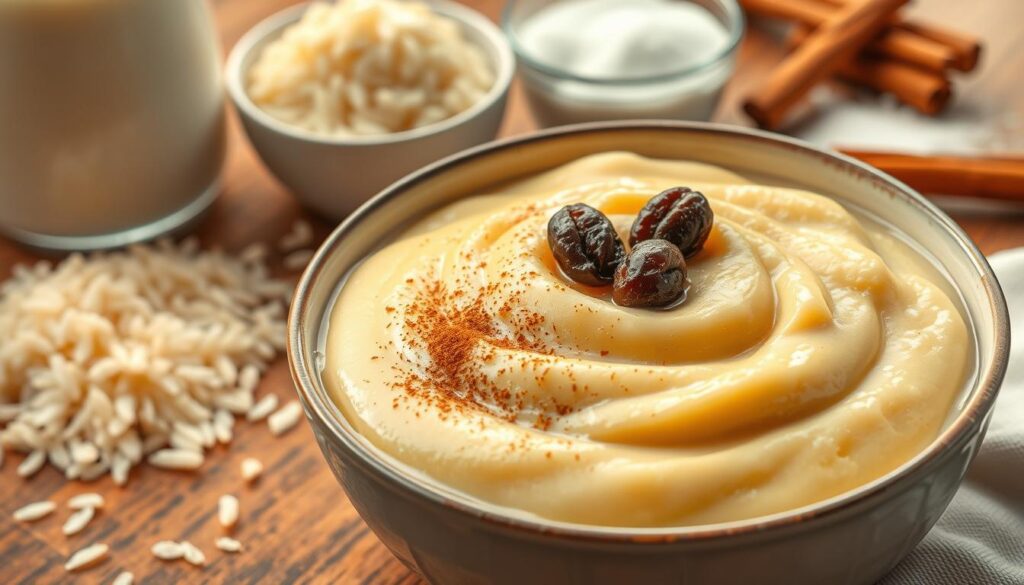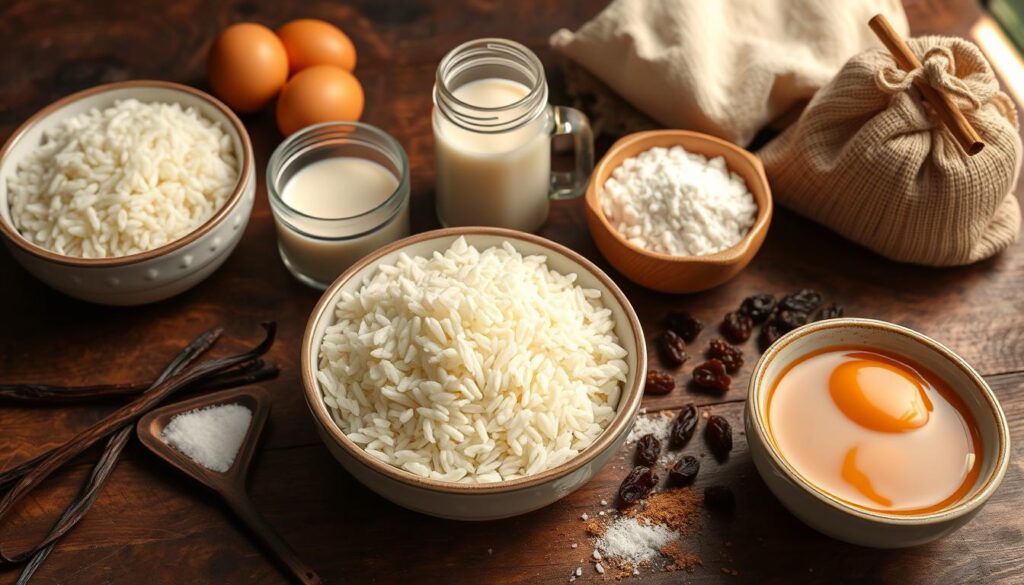Traditional rice pudding is a beloved dessert that has been enjoyed for generations. It’s made from a simple mix of ingredients. Each one is important for the classic taste and texture. Let’s explore the key components of this timeless dish.
Key Takeaways
- Traditional rice pudding is made from a few key ingredients: rice, dairy, and sweeteners.
- The staple grain used is typically short-grain or medium-grain rice, which provides the creamy and starchy base.
- Dairy products like milk, cream, and eggs are essential for adding richness and creaminess to the pudding.
- Traditional sweeteners such as sugar, honey, or maple syrup are used to balance the flavors and create the signature sweetness.
- Regional and cultural variations can influence the specific ingredients and preparation methods used in traditional rice pudding.
Defining Traditional Rice Pudding
Rice pudding is a dish loved for centuries worldwide. At its heart, traditional rice pudding is a creamy treat made by cooking rice in milk or cream. It often includes sweeteners and spices. This recipe has deep roots in many culinary traditions, each adding its own twist.
Origins and Cultural Significance
The history of rice pudding goes back to ancient times. It was valued for its simplicity and flexibility. In many cultures, it holds deep cultural and religious meaning. It’s often enjoyed during special times or as a family heirloom.
Variations Across Regions
- In the Middle East, rice puddings are flavored with saffron. Southeast Asia offers versions with coconut. These show the rich culinary diversity of rice pudding.
- In Europe, traditional rice pudding recipes use cinnamon, vanilla, and raisins. Latin America adds dulce de leche or tropical fruits.
- Despite these differences, traditional rice pudding stays true to its comforting, creamy, and sweet nature. It bridges cultural gaps with its universal appeal.

Core Ingredients of Traditional Rice Pudding
Traditional rice pudding has a few key ingredients that make it creamy and comforting. Whether you’re making a basic rice pudding recipe or checking out the traditional rice pudding ingredients list, knowing the essential rice pudding components is crucial. This knowledge helps you master this classic dessert.
The base of rice pudding is the rice itself. Short-grain or medium-grain white rice is best. It makes the pudding soft and starchy, thickening it nicely. Milk and cream add richness, while eggs give it a smooth texture.
Sweeteners like sugar, honey, or maple syrup balance the pudding’s natural sweetness. Spices like cinnamon, vanilla, or nutmeg add warmth and depth to the flavor.
| Ingredient | Purpose |
|---|---|
| Short-grain or medium-grain white rice | Provides the starchy, creamy texture |
| Milk and cream | Contribute to the rich, creamy base |
| Eggs | Add body and silky mouthfeel |
| Sugar, honey, or maple syrup | Sweeten the pudding |
| Cinnamon, vanilla, nutmeg | Lend warmth and depth of flavor |
Knowing the traditional rice pudding ingredients list and the essential rice pudding components opens up a world of possibilities. You can try classic recipes or create your own unique versions. This celebrates the rich traditions and flavors of different cultures.

What is traditional rice pudding made of?
Traditional rice pudding is a beloved comfort food. It’s made with a mix of key ingredients. At its core is rice, the staple grain. The rice type can vary, with long-grain white, arborio, or short-grain sushi rice being favorites. These types of rice give the pudding its creamy texture.
Rice: The Staple Grain
The type of rice used in traditional rice pudding matters a lot. Long-grain white rice is a top choice because it makes the pudding light and fluffy. Arborio rice, known for its creamy texture, can make the pudding even creamier. Short-grain sushi rice adds a unique, indulgent feel to the pudding.
Dairy: Milk, Cream, and Eggs
Dairy is key to traditional rice pudding’s creamy texture. Whole milk is often the main liquid, making the pudding smooth. Heavy cream or half-and-half can make it even creamier. Eggs are also used, thickening the pudding and giving it a custard-like feel.
| Ingredient | Purpose |
|---|---|
| Long-grain white rice | Provides a light, delicate texture |
| Arborio rice | Lends a creamy, risotto-like consistency |
| Whole milk | Serves as the main liquid base, contributing to the smooth, velvety texture |
| Heavy cream or half-and-half | Enhances the overall creaminess of the dish |
| Eggs | Act as a natural thickener, creating a custard-like texture |
Choosing the right rice and the right amount of dairy makes traditional rice pudding a rich and comforting treat. It’s sure to please anyone who tries it.
Traditional Sweeteners and Flavorings
Traditional rice pudding relies on sweeteners and flavorings for its perfect taste. offering a light, fragrant base. It’s a great match for various sweeteners and spices.
Sugar and Spices
Granulated sugar is the go-to sweetener in rice pudding. It boosts the dish’s natural sweetness. Vanilla extract adds a comforting warmth. Cinnamon brings a subtle, earthy flavor and a hint of warmth.
Nutmeg, cardamom, and rose or orange blossom water are also used. These rice pudding flavorings create a rich, harmonious taste. They make the dish more than just simple rice pudding.
“The key to a truly exceptional rice pudding lies in the careful selection and blending of its sweeteners and spices.”
Whether you like a simple cinnamon-sugar mix or something more complex, these traditional ingredients are crucial. They make rice pudding a delightful and memorable treat.
Cooking Methods and Techniques
There are two main ways to make traditional rice pudding: stovetop simmering and oven baking. Each method has its own benefits, letting you choose what suits you best.
Stovetop Simmering
The stovetop method is a classic for traditional rice pudding. It lets you watch and stir closely. This ensures the rice cooks well and the pudding becomes creamy.
The slow heat breaks down the rice’s starches. This makes the pudding smooth and velvety.
- Put the rice, milk, and other ingredients in a heavy saucepan.
- Heat it over medium, stirring often to avoid sticking or burning.
- Lower the heat and simmer, stirring now and then, until the rice is tender.
- Adjust the sweetness and flavors to your liking, then serve the stovetop rice pudding warm.
Oven Baking
Baked rice pudding is great for those who prefer less effort. You mix the ingredients in a dish and let the oven do the work. The oven’s heat cooks the rice evenly, making it creamy.
- Preheat your oven to about 325°F (165°C).
- Put the rice, milk, and other ingredients in a greased dish.
- Cover it and bake, stirring sometimes, until the rice is tender.
- Serve the baked rice pudding warm or chilled, as you like.
Both stovetop and oven baking have their perks for how to make traditional rice pudding. Your choice depends on what you prefer, how much time you have, and the texture and taste you want.
Regional and Cultural Variations
The world’s desserts are rich with different rice pudding recipes. From the Middle East’s cardamom rice puddings to Southeast Asia’s creamy coconut versions, each culture adds its own twist. This makes rice pudding a beloved treat around the globe.
In India, it’s called “kheer” and often includes saffron, rose water, and pistachios. Latin America’s arroz con leche is sweet with cinnamon. Meanwhile, the Nordic countries keep it simple, letting milk and rice speak for themselves.
Japan’s sekihan rice pudding has azuki beans and mochi. Italy’s riso al latte is creamy and vanilla-flavored. From Brazil’s raisin canjica to Iran’s cardamom shirin polo, each dish offers a peek into a culture’s traditions.
| Region | Rice Pudding Variation | Key Ingredients and Flavors |
|---|---|---|
| Middle East | Muhallebi | Milk, rose water, cardamom |
| India | Kheer | Milk, saffron, pistachios |
| Latin America | Arroz con leche | Milk, cinnamon, sugar |
| Japan | Sekihan | Sticky rice, azuki beans, mochi |
| Italy | Riso al latte | Milk, vanilla, rice |
| Brazil | Canjica | Milk, corn, raisins |
| Iran | Shirin polo | Rice, cardamom, orange zest |
This global tapestry of rice pudding recipes shows how adaptable and meaningful this dessert is. Whether you love the classic version or want to try something new, there’s a world of flavors waiting for you.
Serving and Garnishing Rice Pudding
Rice pudding can be enjoyed in many ways, warm or chilled. The temperature and garnishes can make a big difference. Let’s look at the best ways to serve and garnish this dessert.
Warm or Chilled
You can serve rice pudding warm or cold, depending on what you like. Warm rice pudding is great for cold nights, offering a cozy treat. Chilled rice pudding is refreshing, perfect for hot days or after a big meal.
Toppings and Accompaniments
Rice pudding is fun to customize with different toppings and sides. Here are some tasty ideas:
- Fresh Fruit: Try adding sliced strawberries, mango, or berries for a sweet and fresh touch.
- Nuts and Seeds: Toasted almonds, pecans, or sunflower seeds add crunch and flavor.
- Spices and Herbs: Cinnamon, nutmeg, or mint can make your rice pudding even more aromatic.
- Caramel or Chocolate Sauce: A drizzle of caramel or chocolate sauce makes it extra special.
- Whipped Cream: A dollop of whipped cream adds a light and airy feel.
There are countless ways to serve and garnish rice pudding. Try out different rice pudding toppings and rice pudding accompaniments to find your favorite.
“The true beauty of rice pudding lies in its simplicity and the endless ways it can be customized to suit individual tastes.”
Nutritional Value of Traditional Rice Pudding
Traditional rice pudding is a beloved dessert with a rich nutritional profile. It’s made from rice, dairy, and sweeteners. These ingredients offer health benefits but also impact calorie and macronutrient content.
The main ingredients of rice pudding are rice, dairy, and sweeteners. Each adds to its nutritional value. The rice pudding nutritional information varies by recipe and preparation. Generally, it’s a good source of carbs, protein, and vitamins and minerals.
Carbohydrates and Fiber
Rice in traditional rice pudding is a complex carb source. It provides steady energy. Rice also adds a bit of fiber, which aids digestion.
Protein and Calcium
Dairy like milk and cream add protein and calcium. These nutrients are crucial for strong bones and overall health.
Potential Health Benefits
Traditional rice pudding is a topic of debate on healthiness. Yet, it has some health benefits of rice pudding. These include:
- Complex carbs for sustained energy
- Protein and calcium for bone health
- A comforting and satisfying dessert option
The nutritional value of rice pudding depends on ingredients and preparation. Enjoy it in moderation due to its calorie and sugar content.
| Nutrient | Amount per Serving |
|---|---|
| Calories | 250 kcal |
| Carbohydrates | 35 g |
| Protein | 6 g |
| Fat | 8 g |
| Calcium | 150 mg |
Knowing the rice pudding nutritional information helps you enjoy it wisely. It’s about finding a balance between pleasure and health.
Storing and Reheating Leftovers
Keeping your homemade rice pudding fresh is key. Store it in an airtight container in the fridge for up to 5 days. To reheat, use the stovetop or microwave, stirring often until warm.
If your pudding gets too thick, add a bit of milk or cream. This will make it creamy again. Always check for spoilage, as the shelf life depends on the ingredients.
Follow these tips to enjoy your rice pudding for longer. Your leftovers will be just as delicious as the first time!
